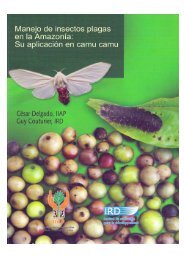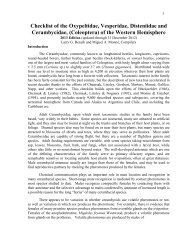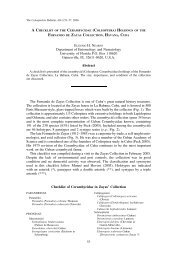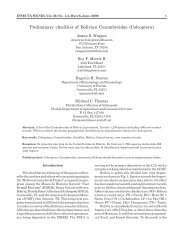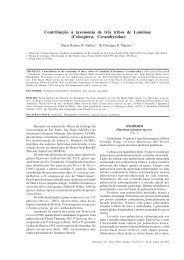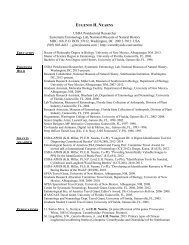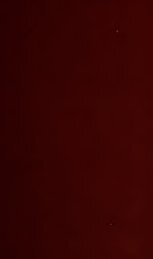You also want an ePaper? Increase the reach of your titles
YUMPU automatically turns print PDFs into web optimized ePapers that Google loves.
98 THE TRIBE ONClDERIl.'1<br />
ccnces s lightly impressed so tha.t each appears to beIlr 11 rounded tubercle anteriorly I<br />
base nearly impullctate. Scutellum transverse, sides short, straight, oblique, apex<br />
strongly rounded. Elytm with sides tapering gradually posteriorly, apices separately<br />
rounded; disk at base coarsely, not densely punctate, punctures gradually<br />
finer and denser behind middle; humeri prominent, anterior margin slightly arcuate,<br />
oblique, angle with a rather indistinct tubercle, from which 0. short, rccurvcd carina<br />
extends to basal quarter or one-third. Prostemum simple, Il!l.rrow, slightly widencd<br />
behind middle. Procoxae anteriorly with a strong uncus; femora clavate, profemor3<br />
very robust, on basal half bene.'tth and above trunsvcrsciy rugose; protarsi. strongly<br />
widened. Fifth sternite one-half again as long as fourth, apex subtruncate. Antenn:te<br />
nearly two-thirds IIgain as long as body, seventh segment surpassing elytral<br />
apex, first five segments fimbriate beneath; scape slender, gradually clavate from<br />
base, entire basal h:\lf tmnsversely rugoe; third segment about onc and one-third<br />
times length of first, moderately sinuous ; fourth and fifth successively shorter, rest<br />
subequal, eleventh slightly elollgnte, acicular, with a short, curved process at apc:x.<br />
Fm.IALrJ. More robust; antenna! tubercles less strongly dentate at :tpex; procoxae<br />
with a broad, feebly elevated tubercle allterioriy; profemora not rugose;<br />
protarsi less strongly e:.:-p:mded; fifth sternite with apex rctuse, apical portion of<br />
disk flattened triangularly, not impressed ; antennae only slightly longer than body,<br />
scnpe not rugose, regmcnts from fourth gradually shorter.<br />
LENGTH 8.5-13.5 mm.; width 3.6-5.5 mm.<br />
Type locality.-Zapote, Guatemala.<br />
D·istribution.-Southern Mexico southward to northern Colombia.<br />
GUATEMALA: ; Alta Vera Paz, on Cacao; (Barber and Schwarz) ; [U.s.N.M.).<br />
PANAMA: , 3 ; Bugaba, 800-1500 fect; (Champion); [M.C.Z.-2 ; U.sN.},'l.<br />
-t , .]. 2 t, 2 ; Cerro Zunil; (Champion); [U.s.N.M.t, ; M.C.Z.<br />
-t, .].<br />
CoLOMBIA: t; Sta. Martha; [M.C.Z.1.<br />
Bates, in the 1885 reference above, lists localities from soutllern<br />
Mexico to Panama.<br />
Furona corniculata Bates<br />
PLATE V, FIGURE 4.<br />
llypmoma corniculata Bates, BioI. Centr.-Amer., Col. v, suppl., 1885, p. 365.<br />
Differs from degenera in the robust body form; humeri more<br />
strongly projecting; elytl'a at base more finely punctate; scape ill<br />
male coarsely grooved on basal half.<br />
MALE. Elongate-ovate, rather robust, body tapering posteriorly; piccous,<br />
covered with light grayish pubescence, variegated and indistinctly mottled with<br />
brown. Head with front largely dark brown, irregularly variegated with ashy and



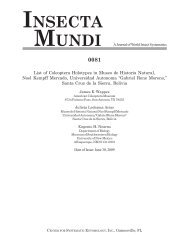
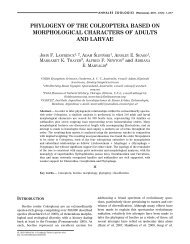


![Coleoptera. Vol. I. [Longicornia. Part I.]](https://img.yumpu.com/41202793/1/180x260/coleoptera-vol-i-longicornia-part-i.jpg?quality=85)
